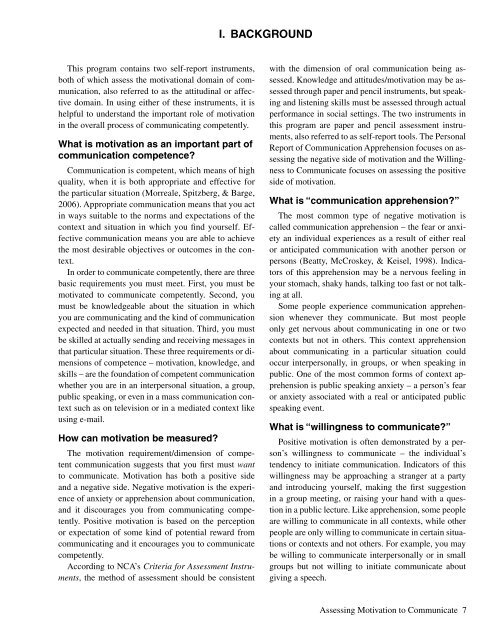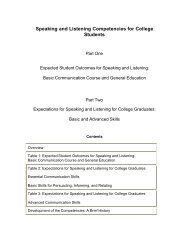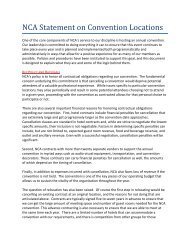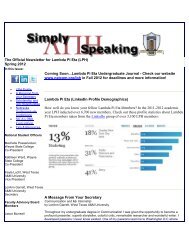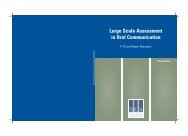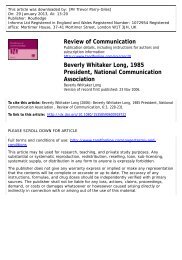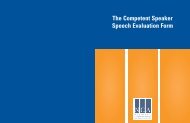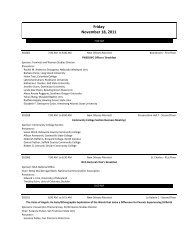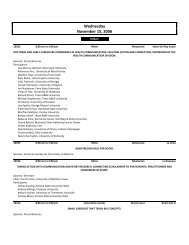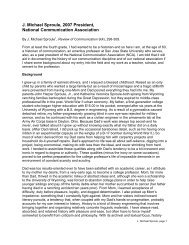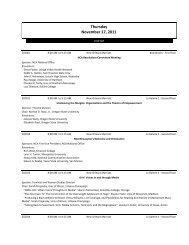Assessing Motivation to Communicate - National Communication ...
Assessing Motivation to Communicate - National Communication ...
Assessing Motivation to Communicate - National Communication ...
- No tags were found...
Create successful ePaper yourself
Turn your PDF publications into a flip-book with our unique Google optimized e-Paper software.
I. BACKGROUNDThis program contains two self-report instruments,both of which assess the motivational domain of communication,also referred <strong>to</strong> as the attitudinal or affectivedomain. In using either of these instruments, it ishelpful <strong>to</strong> understand the important role of motivationin the overall process of communicating competently.What is motivation as an important part ofcommunication competence?<strong>Communication</strong> is competent, which means of highquality, when it is both appropriate and effective forthe particular situation (Morreale, Spitzberg, & Barge,2006). Appropriate communication means that you actin ways suitable <strong>to</strong> the norms and expectations of thecontext and situation in which you find yourself. Effectivecommunication means you are able <strong>to</strong> achievethe most desirable objectives or outcomes in the context.In order <strong>to</strong> communicate competently, there are threebasic requirements you must meet. First, you must bemotivated <strong>to</strong> communicate competently. Second, youmust be knowledgeable about the situation in whichyou are communicating and the kind of communicationexpected and needed in that situation. Third, you mustbe skilled at actually sending and receiving messages inthat particular situation. These three requirements or dimensionsof competence – motivation, knowledge, andskills – are the foundation of competent communicationwhether you are in an interpersonal situation, a group,public speaking, or even in a mass communication contextsuch as on television or in a mediated context likeusing e-mail.How can motivation be measured?The motivation requirement/dimension of competentcommunication suggests that you first must want<strong>to</strong> communicate. <strong>Motivation</strong> has both a positive sideand a negative side. Negative motivation is the experienceof anxiety or apprehension about communication,and it discourages you from communicating competently.Positive motivation is based on the perceptionor expectation of some kind of potential reward fromcommunicating and it encourages you <strong>to</strong> communicatecompetently.According <strong>to</strong> NCA’s Criteria for Assessment Instruments,the method of assessment should be consistentwith the dimension of oral communication being assessed.Knowledge and attitudes/motivation may be assessedthrough paper and pencil instruments, but speakingand listening skills must be assessed through actualperformance in social settings. The two instruments inthis program are paper and pencil assessment instruments,also referred <strong>to</strong> as self-report <strong>to</strong>ols. The PersonalReport of <strong>Communication</strong> Apprehension focuses on assessingthe negative side of motivation and the Willingness<strong>to</strong> <strong>Communicate</strong> focuses on assessing the positiveside of motivation.What is “communication apprehension?”The most common type of negative motivation iscalled communication apprehension – the fear or anxietyan individual experiences as a result of either realor anticipated communication with another person orpersons (Beatty, McCroskey, & Keisel, 1998). Indica<strong>to</strong>rsof this apprehension may be a nervous feeling inyour s<strong>to</strong>mach, shaky hands, talking <strong>to</strong>o fast or not talkingat all.Some people experience communication apprehensionwhenever they communicate. But most peopleonly get nervous about communicating in one or twocontexts but not in others. This context apprehensionabout communicating in a particular situation couldoccur interpersonally, in groups, or when speaking inpublic. One of the most common forms of context apprehensionis public speaking anxiety – a person’s fearor anxiety associated with a real or anticipated publicspeaking event.What is “willingness <strong>to</strong> communicate?”Positive motivation is often demonstrated by a person’swillingness <strong>to</strong> communicate – the individual’stendency <strong>to</strong> initiate communication. Indica<strong>to</strong>rs of thiswillingness may be approaching a stranger at a partyand introducing yourself, making the first suggestionin a group meeting, or raising your hand with a questionin a public lecture. Like apprehension, some peopleare willing <strong>to</strong> communicate in all contexts, while otherpeople are only willing <strong>to</strong> communicate in certain situationsor contexts and not others. For example, you maybe willing <strong>to</strong> communicate interpersonally or in smallgroups but not willing <strong>to</strong> initiate communicate aboutgiving a speech.<strong>Assessing</strong> <strong>Motivation</strong> <strong>to</strong> <strong>Communicate</strong> 7


